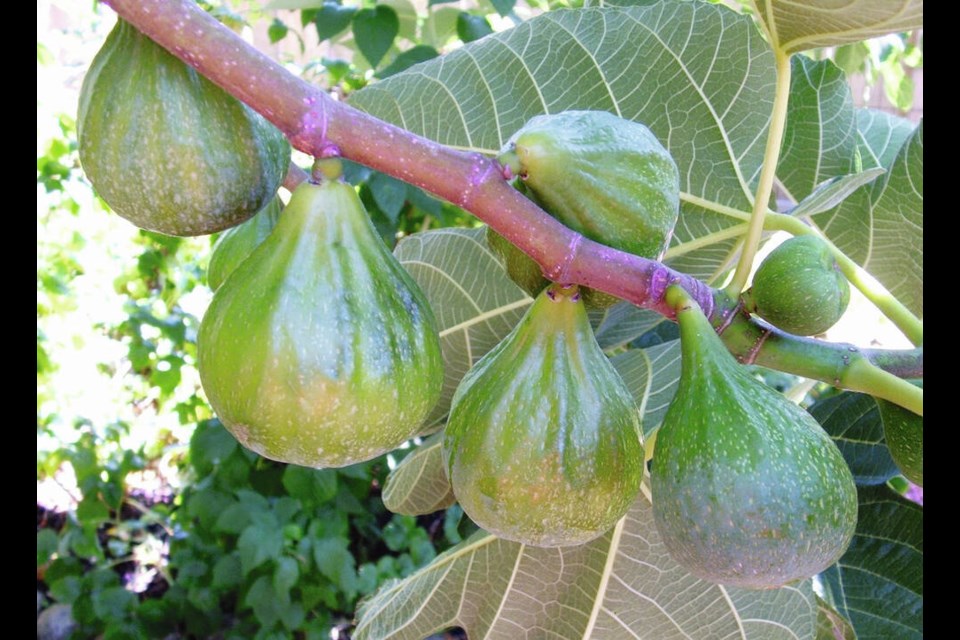Dear Helen: It has been my understanding, and experience, that in our climate the second crop of figs never matures; however, this year, many of the second crop figs on my two Brown Turkey trees actually ripened. I’m wondering whether you’ve heard of others experiencing the same thing. I think this must be one of the ongoing changes climate change is bringing about.
S.M.
My Desert King tree has never ripened the second crop. Fig Trees and More, a nursery and demonstration orchard in North Saanich, lists several that apparently do. Visit fruittreesandmore.com to seed their fig variety list. Before your email, I had not heard of Brown Turkey fig trees producing a second crop.
The first, early August crop of figs is called the breba crop. It ripens on wood produced in the previous year. The second crop, called the main crop, ripens on the current year’s wood, mid-September to mid-October.
According to Fruit Trees and More, figs that will ripen a main crop are Adler, Barbillone, Lattarula (Italian Honey), Lebanese Red and San Antonio. The website gives descriptions of each.
I agree with you that this unexpected ripening of main crop figs on your Brown Turkey trees is likely one of many ongoing changes gardeners have been observing in recent years. Earlier than usual heat waves, hot summers and long periods of drought are calling for dramatic adaptations to long-held gardening practices — and adjustments to usual planting and harvesting seasons.
Dear Helen: I have a thriving “salad garden” of lettuces and other greens. This autumn’s slow cooling and gentle rainfall has favoured these plantings. I recognize the healthful qualities of green salads, and want to find a way to turn these leafy vegetables into a fully satisfying meal. Assorted greens, even in a delicious dressing, does not quite do the trick.
E.U.
I have friends, ones who prefer to eat lightly and have salad meals often, have raised the same issue with me. To “beef” up a blend of leafy greens, I begin by roasting nuts and seeds for inclusion in the salad.
My preferences are walnuts, sunflower seeds and pumpkin seeds. I roast them at around 250 F for about 20 minutes or until the nuts and seeds have reached a high flavour intensity. Roasting usually doubles the flavour.
Especially when walnuts are in the salad, I add chopped apple. Small cubes of a preferred cheese help to make a green salad a satisfying meal My choice is usually feta or goat cheese. For colour and crunch, try thin slices of red cabbage or/and chopped bok choy (my preference over celery). Onion contributes a little zest. Toss with a tasty dressing and top with freshly grated parmesan.
I grow endive, escarole and radicchio — bitter greens that I like in salads. When they constitute a significant portion of a salad, I often add some sweet fruit, such as roasted fig halves. Roasted pecans go well with these salads.
Still keeping a green salad as the featured meal, I sometimes accompany it with buttered toast, or a slice of cheese-topped bread baked until the cheese is bubbly and golden.
Dear Helen: Last year and again this year, raccoons have destroyed my tomato plants. Is there anything that will deter them? The plants are in a fenced (over two metres high) area.
D.M.
There are motion-activated devices that emit light, water, or sounds that deter raccoons. Some people find them effective.
Probably the only sure way to bar access to the plants is a wire cage with an improvised door that can be tied securely shut. A complete cage, with overhead coverage, is needed. Raccoons are nimble climbers.
GARDEN EVENT
View Royal meeting. The View Royal Garden Club will meet this evening (Wednesday, Oct. 25) at 7:30 p.m. in Wheeley Hall, behind Esquimalt United church, 500 Admirals Rd. Entrance off Lyall St. Mike Rogers, a keen grower of ornamental grasses, will speak about the continuing transformation of his front yard from bare cobbles to its current state of exuberant waving and shimmering foliage. He will demonstrate tips on planting, upkeep and propagation. A judged mini-show will feature exhibits from members’ gardens. Everyone is welcome Non-member drop-in fee $5. viewroyalgardenclub.ca.



